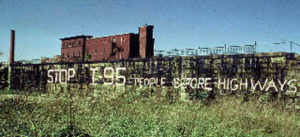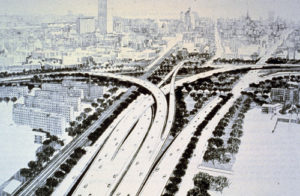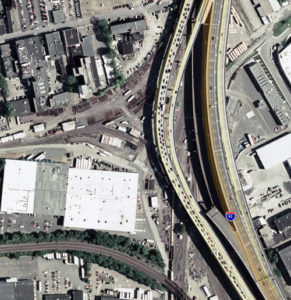TBT: Boston’s Southwest Corridor
06.19.2014 | HMMH |I’m at an FAA training session on FAA Order 1050.1F, Policies and Procedures for Considering Environmental Impacts (currently in draft). In preparation, I did a google-walkabout on the Environmental Policy Act, and eventually found my way to this photo, which was a fixture of my childhood (not the photo, the graffiti):
Here’s a bit of backstory on the “People Before Highways” movement of the late 1960s, which (according to this History of the Inner Belt and even Wikipedia) added additional public pressure to President Nixon to enact NEPA in 1969.
The Inner Belt was a proposed interstate highway that was an 8-lane expressway that would have begun at Route I-93 in Somerville and circled through Cambridge near Central Square, crossed the Charles River near the BU Bridge, touched a portion of Brookline, crossed the Fenway and passed the Museum of Fine Arts, moved on through the Roxbury section of Boston to connect to the Southeast Expressway at the point where it joins the Central Artery heading toward downtown Boston. The Inner Belt and Central Artery thus would have joined to create a ring road around and through the inner Boston area, with major intersections along it: at a proposed extension of Route 2 from Alewife, at the Turnpike in Allston, at a proposed Southwest Expressway (I-95 South) originating in Dedham, at the Southeast Expressway, at a new tunnel under Boston Harbor (I-95 North).
Opposition to the Southwest Expressway originated with environmentalists in the outer suburbs and neighborhood activists in the inner city. A group of city planners, community activists, universities, and politicians formed a coalition that by 1969 had become a region-wide alliance that included groups and officials from Brookline, Cambridge, Dedham, Lynn, Milton, Needham, Revere, Saugus, Somerville and Boston’s East Boston, South Boston, Roxbury, Jamaica Plain, Hyde Park, and the South End.
As a seven-year-old, I remember my mother dragging me to these protests during the summer of 1969. I’m guessing I was promised a popsicle if I didn’t whine too much – and probably had to wrangle my three younger siblings for full payment. All I really remember is lots of people and hot sidewalks, though I do recall that it was a big deal when Governor Sargent “stopped” the project.
How ironic that 45 years later, most of my career would have been dedicated to implementing the basic tenets set forth in the NEPA preamble:
“To declare a national policy which will encourage productive and enjoyable harmony between man and his environment; to promote efforts which will prevent or eliminate damage to the environment and biosphere and stimulate the health and welfare of man; to enrich the understanding of the ecological systems and natural resources important to the Nation; and to establish a Council on Environmental Quality.”
[National Environmental Policy Act, 1969]
I often wonder if the multi-million dollar studies now conducted in “accordance with NEPA” are really what folks like my mother had in mind when they were looking for a little more transparency in the process (though I’ll bet you they didn’t use those words. Just sayin’.)
The happy ending (in case you were unaware): I-95 was stopped (though there’s still a ramp to nowhere in Somerville), the MBTA’s Orange Line has brought incredible development to an otherwise neglected part of the city – including a lovely linear Southwest Corridor Park and expansion of Northeastern University. And eventually the Big Dig addressed some of the traffic problems. But that’s a story for another day.








